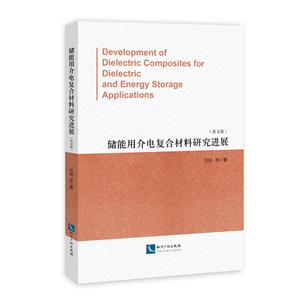C o n t e n t s
Chapter 1 Introduction and Research Objectives ··········· 1
1.1 Theory of Dielectric Materials ··································· 2
1.1.1 Permittivity ··················································· 2
1.1.2 Dielectric Loss ··············································· 4
1.1.3 Relaxation····················································· 6
1.2 Classification of Dielectric Materials ··························· 8
1.2.1 Non Polar Materials·········································· 9
1.2.2 Polar Materials ··············································· 9
1.3 Application of Dielectrics ······································· 12
1.3.1 High/Low Permittivity······································ 12
1.3.2 Energy Storage ·············································· 13
1.3.3 Wearable Electronics ······································· 17
1.4 Dielectric Composites ··········································· 18
1.4.1 General Concepts of Composites ·························· 18
1.4.2 Flexible Polymer-Based Dielectric Composites ········· 20
1.4.3 Ceramic-Glass Dielectric Composites ···················· 29
1.4.4 Interface Effect in Composites ···························· 30
1.5 Objectives of Research ·········································· 32
References ······························································· 33
Chapter 2 Preparation and Characterization Methods ····· 47
2.1 Raw Materials ···················································· 48
2.1.1 MXene 2-D Material Ti3C2Tx ····························· 48
2.1.2 Calcium Copper Titanate CaCu3Ti4O12·················· 50
2.1.3 Barium Titanate BaTiO3···································· 51
2.1.4 Barium Strontium Titanate Ba0.5Sr0.5TiO3 ············· 54
2.2 Conductor-Polymer Composite Fabrication ··················· 56
2.2.1 Preparation ··················································· 56
2.2.2 Optimization ················································· 56
2.3 Ceramic-Polymer Composite Fabrication ····················· 60
2.3.1 Preparation ··················································· 60
2.3.2 Optimization ················································· 61
2.4 Ceramic-Glass Composite Fabrication ························· 63
2.4.1 Preparation ··················································· 63
2.4.2 Optimization ················································· 66
2.5 Characterization Methods ······································· 69
2.5.1 Crystalline Structure Determination ······················ 69
2.5.2 Microstructure Analysis ···································· 70
2.5.3 Dielectric Properties Analysis ····························· 71
2.5.4 Energy Density Calculation ································ 72
References ······························································· 73
Chapter 3 Conductor-Polymer Composite Using 2-D
Conductive Fillers ·································· 79
3.1 Introduction ······················································· 80
3.2 Samples···························································· 81
3.3 Structure and Morphology Characterization ·················· 82
3.3.1 X-ray Diffraction············································ 82
3.3.2 Differential Scanning Calorimetry ························ 83
3.3.3 Scanning Electron Microscopy ···························· 86
3.3.4 Fourier Transform Infrared Spectroscopy ················ 87
3.4 Dielectric Properties ············································· 90
3.4.1 Frequency Dependency of Dielectric Properties at
Room Temperature ·········································· 90
3.4.2 Temperature Dependency of Dielectric Properties ······ 92
3.4.3 Dielectric Properties at High Electric Fields ············ 94
3.5 Discussion ························································ 97
3.5.1 Percolation Threshold ······································ 97
3.5.2 Effect of Silicon Coupling Agent ························105
3.5.3 Crystallinity Increase Due to Filler Addition ···········107
3.6 Summary ························································· 111
References ······························································ 112
Chapter 4 Ceramic-Polymer Composite with
Coupling Agent····································· 115
4.1 Introduction ······················································ 116
4.2 Samples··························································· 117
4.3 Structure and Morphology Characterization ················· 118
4.4 Dielectric Properties ············································ 121
4.4.1 Dielectric Properties with Different
Filler Contents ··············································121
4.4.2 Temperature Dependency of Dielectric
Properties ····················································125
4.5 Discussion ······················································· 127
4.5.1 Coverage of Silicon Coupling Agent ·····················127
4.5.2 Effect of Silicon Coupling Agent on
Dielectric Properties ·······································130
4.6 Summary ························································· 133
References ··························································· 134
Chapter 5 Ceramic-Glass Composite ························137
5.1 Introduction ······················································ 138
5.2 Sample and Systems ············································ 139
5.3 BaTiO3-SiO2 Composites Prepared by
Conventional Sintering ·········································· 141
5.3.1 Structure and Morphology Characterization ············141
5.3.2 Dielectric Properties ·······································149
5.3.3 Discussion ··················································156
5.4 Ba0.5Sr0.5TiO3-SiO2 Composites Prepared
by Conventional Sintering ······································ 164
5.4.1 Structure of Composites ···································164
5.4.2 Dielectric Properties ·······································167
5.4.3 Discussion ··················································172
5.5 Summary ························································· 175
References ······························································ 178
Chapter 6 Conclusions and Perspectives ····················181
6.1 Conclusions ······················································ 182
6.2 Perspectives ······················································ 185



















